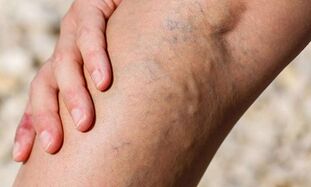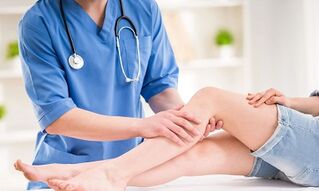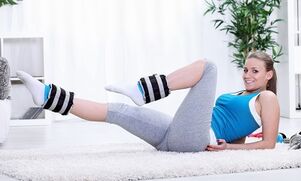
Varicose veins are a fairly common pathological condition, characterized by an increase in lumen diameter, thinning of the venous wall and the appearance of "knots".
Translated from ancient Greek, "varicose veins" means "swollen". Theoretically, a similar disease can appear anywhere on the body, but the most common lesion is the foot.
The essence of the problem
The veins in the body play a very important role, representing a network of branching reservoirs that carry blood from the tissues to the heart muscle. At the bottom of the foot, this network is expressed in the form of deep and superficial veins, which are interconnected with the emergency blood vessel system.
As a rule, the main focus is on the deep veins, so it looks stronger and bigger. And on the surface, about 15% of the total work is still there.
The heart is the "pump" that moves blood through the veins. Some blood flows through the veins against gravity (when walking, moving or squatting). When a muscle is relaxed (while standing), blood flows downward, under the influence of the same gravity. But not everything is easy, the valves located on the walls of the ship do not let it back.
If the valve is "broken", the veins dilate and become inflamed, it can not maintain blood flow. This process contributes to the swelling and swelling of the veins. Disrupted blood supply becomes the root from which varicose veins in the legs begin.
Causes of varicose veins
There are many reasons for this:
- Varicose veins may be inherited, i. e. there is a congenital weakness in the vascular wall.
- The occurrence of varicose veins can be associated with human activity and immunity.
One thing is for sure, this disease does not just happen, something should be an impetus.
During inactive work in the veins, or more precisely in the pelvis, blood stasis occurs, which then manifests itself in health problems. Varicose veins arise from an unstable lifestyle, therefore, with regular work, there is no obstacle to its origin.
It is no coincidence that this disease, first of all, is referred to as the occupational disease of sellers and hairdressers.
The following is also a clear provocateur:
- overweight (obesity),
- Frequent weight gain
- leg injury.
Another factor is increased intra-abdominal pressure. Vein size is constantly changing, inhalation - narrow veins, respiration, on the contrary, expand. When a person pushes hard, the veins are under heavy load and under the pressure created begins to expand.
Of course, this does not mean that everyone is at risk, but constipation and chronic cough can cause varicose veins.
Varicose veins during pregnancy

Varicose veins are very common in pregnant women. The ever-expanding uterus puts unintentional pressure on the veins of the legs. In this case, nature has protected women from serious consequences and endowed the body, during pregnancy, with a sufficient amount of sex hormones, which makes the walls of plastic vessels flexible. As a rule, here the disease can be cured; after giving birth, the veins return to their previous state.
Preventive methods
Absolutely disease is easier to prevent than to cure, and varicose veins are no exception. Let’s take a look at the key precautions:
- Forget tight and uncomfortable shoes. Women should remember that the heel "every day" should not be more than five centimeters. At night, enjoy your feet with a massage and a cool bath, then place higher and lie down in this position for 15 minutes.
- Wear loose-fitting clothes that do not have tight elastic straps or belts.
- Walk barefoot on the gravel if possible. At the very least, arrange this therapy yourself while on vacation.
- Control your diet. Eliminate, or at least reduce, the consumption of spicy, salty and smoked foods. The same is true for alcohol.
- Exercise is an excellent prevention of varicose veins. Exceptions may be an early stage of the disease. If you see the first signs and symptoms in yourself, then your load should be weak and before starting training, be sure to see your doctor.
- If you have an inactive job, try to get up as often as possible and walk around the room. Do basic exercises, at least a little jump. Do not cross your legs while sitting, this is very bad for blood circulation.
- Do not overdo it with baths, saunas and hot tubs. After the "hot" procedure, be sure to rinse with cold water.
Stages of varicose vein development
- First stage.Pain and discomfort are absent, only cosmetic defects are observed. On the legs there is a pattern of branched veins, "stars" and "mesh" appear. In the evening, the legs swell badly.
- The second stage.There is obvious swelling in the ankle area and heaviness in the foot. At night, cramps, numbness, pins and needles may occur.
- Third level.Persistent swelling of the feet, the appearance of seals on the skin, changes in pigmentation in place, itching and dermatitis appear.
- Fourth level.Trophic ulcers appear on the skin of the feet.
What steps should be taken at an early stage

Varicose veins in the lower part of the leg, if at an early stage, respond well to treatment, it is very likely that a competent "fight" will stop its development.
First, follow all the precautions mentioned above. Review your wardrobe, if necessary, remove all "dangerous" things, do the same with shoes. Give your feet a contrast bath, walk more barefoot, and balance your diet.
Second, at the first symptom, buy compression underwear, can be tights or stockings. The principle of their action is to spread the pressure on the feet in such a way that the blood circulation is normalized, and the symptoms become weak.
Regarding consultations, you must visit not only a phlebologist, but also a gynecologist (for women) and an orthopedist. Possible hormonal contraceptives or flat feet may cause circulatory problems.
Prevention of varicose veins during pregnancy
Almost every woman during pregnancy has problems with swollen feet and circulatory disorders. The enlarged uterus constantly presses on the inferior vena cava, interfering with its normal function.
But, as mentioned above, varicose veins in this case can be cured, the main thing is to take the necessary preventive measures in time.
- Buy comfortable orthopedic shoes so your feet will not get tired while walking.
- Take a walk every day. Do not sit or stand for long. To prevent venous stasis, place your feet on a hill while resting.
- Wear compression clothing to prevent swelling.
- Light physical exercise that only involves the feet would be a good help. The simplest movement of the legs in different directions is enough.
- Vitamin C is very good in the prevention of varicose veins. It has many beneficial nutrients that will provide elasticity to the veins, while reducing the risk of many diseases.
Treatment of varicose veins
Complete healing of a disease is only possible in a manageable way. Medications and exercises are used as additional methods.
Phlebectomy
Surgery can be performed surgically or using the latest technology. The first includes phlebectomy, when varicose veins are removed.
Laser
In the second group there is a laser freezing, no incision, hot radiation is applied to the problem area of the body.
Sclerotherapy
Another way to get rid of varicose veins is sclerotherapy. A special solution is injected into the damaged vein, using a thin needle, which attaches to the wall of the blood vessel and then dissolves it.
But no matter how doctors want, they can not eliminate the main cause of varicose veins - the weakness of the vessel wall. Only with your power to prevent disease through preventive measures.
Special training

Below we list some physical exercises that will not take much of your time, but the effect will be great. You can do it at home.
- Exercise 1.Lie on the floor, lift your feet to a 90 ° angle with the floor, and start moving your toes "away from you". Repeat 10 times.
- Exercise 2.In a cartilage position, lift the leg and "draw" a circle with your foot, 10 times in each direction.
- Exercise 3.Common "Birch" has a good effect. From a prone position, lift your legs and pelvis, place the latter in your hands. Lock this position for a few seconds. Repeat 4 times.
- Tip:Take some time to stretch. First, your body will always be flexible, and secondly, it will contribute to the transfer of blood from the veins.
- Exercise 4.Lying on the floor with feet together, knees pointing in different directions. Hold your legs and pull towards you. Remain in this position for a while. Play exercise 4 times.
- Exercise 5.Lie on your left side and rest on your elbows, with your right hand grabbing your right foot. Perform some spring movements with your hips backwards (trying to reach the heel to the back), lingering for 10 seconds. Do the same for the left side.
Ointment
The purpose of medicines in the treatment of varicose veins is to give elasticity and normal condition to the veins. The necessary medication will be recommended by a specialist for complex treatment.
Creams containing anticoagulants can have a good prophylactic effect. The last role is to relieve pain in the affected area, as well as to strengthen blood vessels. Often, the preparation of anti-varicose creams contains a number of vitamins: C, B5 and B1, thanks to them the period of regrowth is reduced.
Pills are also common in treatment, which:
- improves vascular tone;
- relieves inflammation;
- accelerates blood flow and lymph flow;
- eliminates microcirculation disorders.
Tablets are divided into several groups: corticosteroids, phlebotonics, antithrombotic and non-steroidal analgesics.
People's solution

Conservative treatment methods are effective in the first stage of varicose veins, when a person feels heavy in the legs and sees the venous tissue on the skin. The sooner corrective action is taken, the faster and more accurate the results will be. Here are some simple but effective recipes.
Garlic compress
Gruel is prepared from garlic and grated butter, in a ratio of 1: 2, which is then applied to the affected area, fixed with paper and bandage. Exposure period - night, in the morning rinse your feet with warm water.
Chestnut
Chestnut tincture for internal use. Pour fifty grams of dry product with 500 ml of alcohol. The resulting product must be forced for 14 days, filtered. Take three times a day before meals with water.
Kalanchoe Ointment
One liter jar should be half filled with leaves and the rest filled with 70% alcohol. The resulting tingtur should be placed in a dark place for two weeks, but shake it daily. The ointment is ready to be applied daily on the damaged area.
Love yourself and be healthy!




































